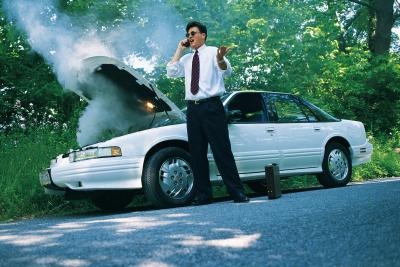
The water pump on any vehicle functions as the heart of the cooling system. The automotive water pump, typically driven by a belt and pulley arrangement, has interior impellers inside the housing that spin at a high rate of speed to circulate water. The faster the vehicle goes, the larger the volume of coolant that enters the engine. Water pumps can fail for a variety of reasons, which include defective seals, bearings, impellers and belts. A vehicle owner can narrow down troublesome symptoms by looking for specific clues that point problems to with the water pump, and that only.
If the vehicle begins to overheat and stay in a temperature range that shows above normal conditions, the likely suspect is the water pump. If the coolant remains at the proper level with no leaks, and the thermostat functions properly, the higher than normal temperature could indicate worn water pump impellers that have rusted and chipped. Plastic impellers on some cars can break, reducing the circulation pressure. A constant, higher than normal engine temperature could be caused by damaged impellers.
To find a water pump leak, a vehicle owner can place a piece of white typing paper under the water pump and let it remain overnight. This works best if the car has been driven for some time. Checking the paper the next morning will indicate if any leakage has occurred. The paper will be wet, usually colored green or orange -- the color of the coolant. The leak could come from the water pump housing gasket or the "weep" hole at the bottom of the water pump.
The weep hole on a water pump serves as a bypass vent or hole. It is located on the very bottom of the water pump housing. When the interior seal degrades in the water pump, coolant bypasses the seal and leaks externally. Any drips from this small hole indicates that the seal has failed, and possibly the shaft bearings. A failed seal requires water pump replacement.
Water pumps have inner and outer shaft bearings that hold the impeller shaft. They have factory sealed bearing cups that serve as permanent lubrication. When the shaft bearings deteriorate, excess play results in the hub and pulley. Any wobble in the water pump pulley while the engine runs points to bad shaft bearings. A vehicle owner can manually pull the pulley from side to side and up and down, to find any excessive play in the shaft. Worn shaft bearings require water pump replacement.
Faulty water pump bearings make a distinctive noise when they have worn or failed. They have a low frequency growling or gravelly sound during engine operation. The noise can be heard particularly when the vehicle is idling. Placing a screwdriver against the top of the pump housing and listening to the other end against the ear can magnify and isolate the sound. Rust and bits of metal inside the bearing caps causes the growling, and sometimes scraping, noise. Bad bearings require water pump replacement.
The water pump belt drives the pump pulley. If the belt slips or has become disconnected, the water pump can longer force coolant through the system. Worn and slipping belts typically squeal upon engine start-up. Worn or broken belts must be replaced to guard against severe engine overheating.